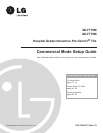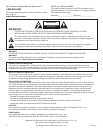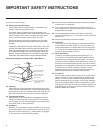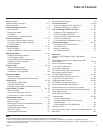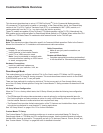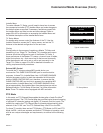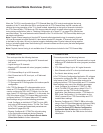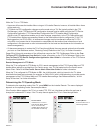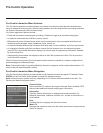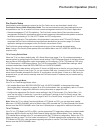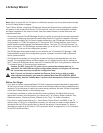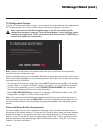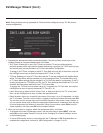
7
206-4271
Commercial Mode Overview (Cont.)
Typical Installer Menu
TV Setup Menus
Installer Menu
To create a Master TV Setup, you will need to know how to access
the commercial controller (PTC) Installer Menu and make changes to
the default values as required. If necessary, familiarize yourself with
the Installer Menu and how to make and save changes. Refer to
pages 35 to 45 for information on accessing the Installer Menu and
for detailed descriptions of the Installer Menu items.
TV Setup Menus
On-screen setup menus control the features of the TV. Use the
Installer Remote to access the TV setup menus, and set the TV
features to the desired configuration for the end user.
Cloning
Cloning refers to the process of capturing a Master TV Setup and
transferring it to a Target TV. The Master TV’s clonable setup menu
features should be configured as part of the Master TV Setup. If
there are features in the Master TV’s setup—channel icons or labels,
digital font options, etc.—that are not set or that are set incorrectly,
those features also will not be set or will be set incorrectly in the
Target TVs. Refer to pages 53 to 58 for detailed information on
cloning requirements and procedures.
External MPI Control
To control the TV using an external MPI control device, you
must use the TV’s GAME CONTROL/MPI port for communication
purposes. In these TVs, Installer Menu item 118 POWER SAVINGS
controls the power circuitry for both the embedded b-LAN module
and the GAME CONTROL/MPI port; therefore, to ensure that the
GAME CONTROL/MPI port circuitry is powered, thus enabling MPI
communication, Installer Menu item 118 POWER SAVINGS must
be set appropriately. See Installer Menu item descriptions as well as
Reference section, “b-LAN Setup & Overview,” for further information.
Note: These TV models are not equipped with MPI card slots.
xxLY770M PTC INSTALLER MENU
CPU-CTV
000 INSTALLER SEQ 000
UPN 000-000-000-000 ASIC D279
PTC V1.00.020 CPU V3.00.34.01
Channels
Picture Mode
Sound Mode
Standard
Aspect Ratio
16:9
Sleep Timer
O
Quick
Picture
Sound
General
Safety
Accessibility
QUICK SETTINGS
^
^
FTG Mode
In this mode, an FTG Channel Map enables the decryption of each Pro:Idiom
®
encrypted channel. The FTG Channel Map also provides logical channel mapping
of physical RF channels (analog and digital), IP channels, and Aux inputs. The
method for creating the FTG Channel Map is ultimately determined by which
element of the TV will “own” the FTG Channel Map—the CPU or the EBL.
For these TV models, there are two FTG Modes—FTG Mode via CPU and FTG
Mode via EBL—which are separate and distinct FTG Modes of operation, each
with its own unique advantages and requirements, as outlined on the following
page.



